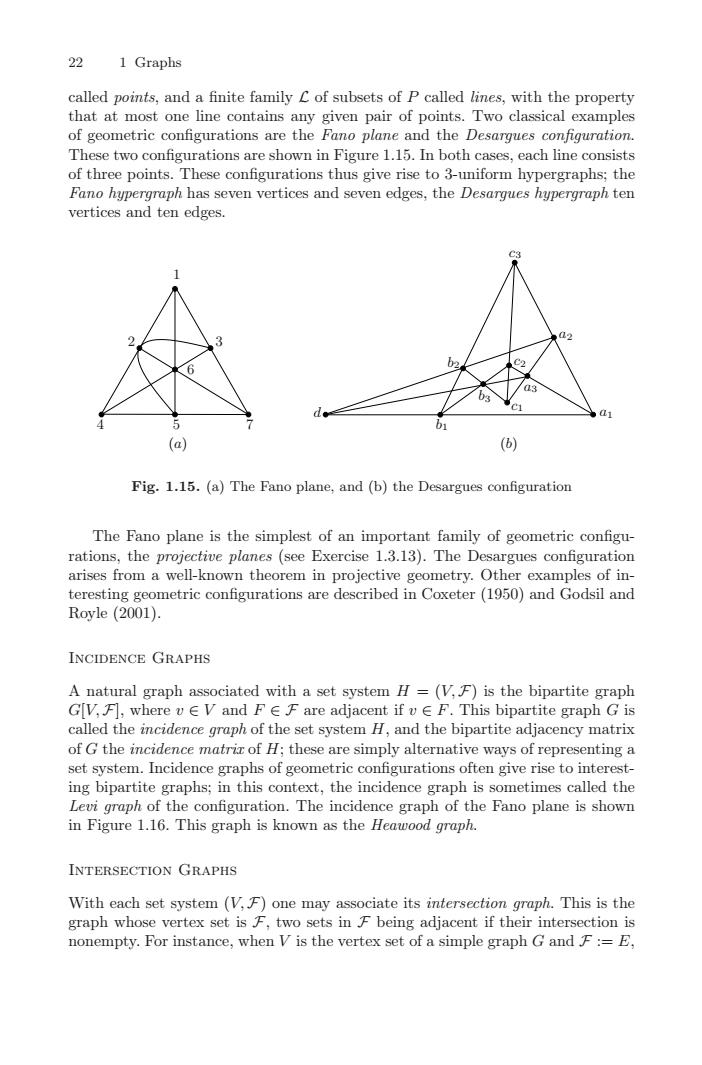正在加载图片...

221 Graphscalled points, andafinitefamily ofsubsets of Pcaled lines, withthe propertythat at most one line contains any given pair of points. Two classicalexamplesof geometric configurations are the Fano plane and the Desargues configurationThese two configurations are shown in Figure 1.15. In both cases, each line consistsof three points. These configurations thus give rise to 3-uniform hypergraphs; theFano hypergraph has seven vertices and seven edges, the Desargues hypergraph tenvertices and ten edgesa(a)(6)Fig. 1.15. (a) The Fano plane, and (b) the DesargueconfigurationThe Fano plane is the simplest of an important family of geometric configu-rations.theprojectiveplanes (see Exercise 1.3.13).The Desargues configurationarises from a well-known theorem in projective geometry. Other examples of interesting geometric configurations are described in Coxeter (1950)and Godsil andRoyle (2001).INCIDENCE GRAPHSA natural graph associated with a set system H -(V,F) is the bipartite graphGV.Flwherew EV and FEFare adjacent if EF.This bipartitegraph G iscalled the incidence graph of the set system H, and the bipartite adjacency matrixof Gthe incidencematrirof H:theseare simply alternativeways of representing aset system. Incidence graphs of geometric configurations often give rise to interesting bipartite graphs; in this context, the incidence graph is sometimes called theLevi graph of thconfiguration. The inciclence graph of the Fano plane is shownin Figure 1.16. This graph is known as the Heawood graph.INTERSECRAPHWith each set system (V,F) one may associate its intersection graph. This is thegraph whose vertex set is F, two sets in F being adjacent if their intersection isnonempty. For instance, when V is the vertex set of a simple graph G and F :=- E,22 1 Graphs called points, and a finite family L of subsets of P called lines, with the property that at most one line contains any given pair of points. Two classical examples of geometric configurations are the Fano plane and the Desargues configuration. These two configurations are shown in Figure 1.15. In both cases, each line consists of three points. These configurations thus give rise to 3-uniform hypergraphs; the Fano hypergraph has seven vertices and seven edges, the Desargues hypergraph ten vertices and ten edges. 1 2 3 4 5 6 7 a1 b1 c1 a2 b2 c2 a3 b3 c3 d (a) (b) Fig. 1.15. (a) The Fano plane, and (b) the Desargues configuration The Fano plane is the simplest of an important family of geometric configurations, the projective planes (see Exercise 1.3.13). The Desargues configuration arises from a well-known theorem in projective geometry. Other examples of interesting geometric configurations are described in Coxeter (1950) and Godsil and Royle (2001). Incidence Graphs A natural graph associated with a set system H = (V, F) is the bipartite graph G[V, F], where v ∈ V and F ∈ F are adjacent if v ∈ F. This bipartite graph G is called the incidence graph of the set system H, and the bipartite adjacency matrix of G the incidence matrix of H; these are simply alternative ways of representing a set system. Incidence graphs of geometric configurations often give rise to interesting bipartite graphs; in this context, the incidence graph is sometimes called the Levi graph of the configuration. The incidence graph of the Fano plane is shown in Figure 1.16. This graph is known as the Heawood graph. Intersection Graphs With each set system (V, F) one may associate its intersection graph. This is the graph whose vertex set is F, two sets in F being adjacent if their intersection is nonempty. For instance, when V is the vertex set of a simple graph G and F := E